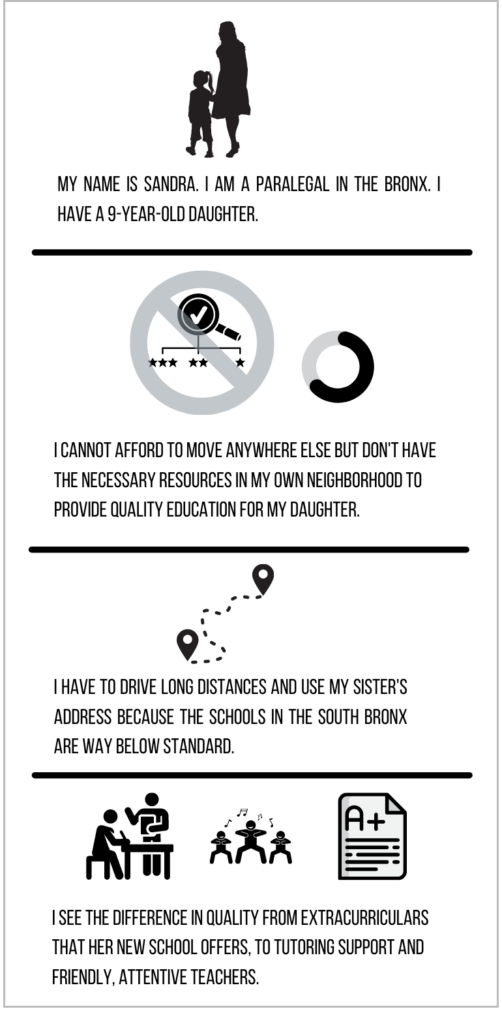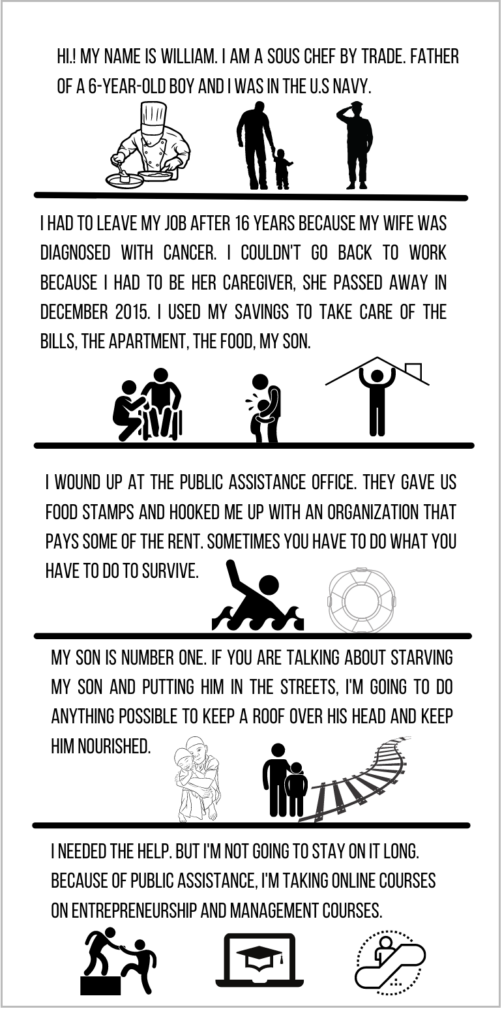3
Design and build new systems
Changing the narratives that reinforce poverty
INTRODUCTION
We’re applying behavioral insights to address not just the day-to-day challenges of poverty, but the deeply entrenched—and typically false—storylines used to justify systems and structures that perpetuate inequality.

CHALLENGE
The U.S. is the world’s richest country by many measures, from GDP to total number of billionaires.
Yet tens of millions of Americans live in poverty, struggling to make it from month to month, if not day to day—and typically holding little hope that their children will find better opportunities. Of those born into the lowest fifth of the population by income, more than 60% will spend their lives excluded from the security and prosperity of the middle class.
Not having enough money constricts people’s lives.
It tends to narrow their field of vision, making it difficult to plan or adequately account for anything beyond immediate needs. Someone constantly juggling insufficient resources pays a “cognitive tax” that further erodes their ability to focus on long-term planning and well-being.
The stunting effects of poverty on individual lives take a cumulative toll, reducing U.S. economic activity by an estimated $500 billion annually, or about 5% of GDP.
For decades, governments at all levels have introduced measures to change this. But too often such initiatives haven’t gone far enough, and those that did work weren’t sustained. We know what it takes to reduce poverty; there are proven programs backed by solid evidence. However, as a nation we’ve lacked the political will to support them.

For ideas42, this is the next frontier in behavioral science. We need to rigorously examine all narratives supporting the systems that keep people in poverty and limit their ability to lead lives of their own choosing—so those narratives can be changed.

Our initial work in this area focused on existing programs.
We looked, for example, at the Earned Income Tax Credit (EITC), Supplemental Nutrition Assistance Program (SNAP), and Temporary Assistance for Needy Families (TANF). We identified inefficiencies and design flaws that prevent such programs from helping the people they’re meant to serve. Then, applying behavioral insights, we created simple yet powerful fixes to make them work better and expand their positive impact.
Such outcomes are gratifying. But we know we can do better—by going deeper.
As we’ve helped address the everyday challenges faced by those with less, we’ve gained insights into what it means to experience chronic scarcity. We’ve also learned a great deal about social attitudes and behaviors toward those who live in poverty.

Poverty isn’t just a set of economic facts. It’s framed by widely endorsed narratives that are used to justify the status quo and prevent systemic change.
Typically imposed by others (and often accepted as destiny), these storylines are meant to explain why some people have less and to rationalize their bad luck—if not consign them, however regrettably, to an unavoidable fate. In the poverty narratives woven through our society, the possibility of change is regularly eclipsed by the supposed inevitability of what remains the same.
These narratives, while tough to change, aren’t written in stone. Like the contexts and individual actions that ideas42 works to reframe in all our work, they’re expressions of human behavior. We’re able to analyze the motivations and worldviews of the people who embrace them. And when those narratives are harmful, ascribing poverty to laziness or other moralistic judgments of inadequacy, we can intervene—not just with targeted nudges, but with a rethinking of broader support systems and their underlying assumptions. Behavioral science, with its experimental methodology and deep understanding of human actions and beliefs, is uniquely positioned to design innovative approaches to narrative change.
Effecting this kind of system change starts with replacing false and damaging “explanations” of poverty.
If we’re truly committed to reducing inequality, the first crucial step is to identify and deconstruct these persistent narratives.
RESPONSE
The narratives that emerge to account for poverty and to justify specific remedies vary widely.
They reflect the values and biases—both negative and positive—of the people creating them, as well as the contexts in which they arise. We can group these false storylines into larger families or meta-narratives, paraphrasing the points of view as follows:
Personal
People with low incomes have personal faults that cause them to live in poverty. Their negative attributes—being less hard-working, or uninterested in self-improvement, or of low intelligence—impede them from prospering.
Meritocracy
Poverty is the result of not working hard enough. Anyone can escape it if they “pull themselves up by their bootstraps” and make the necessary effort. (Those who endorse this narrative tend to favor rags-to-riches stories of people who’ve come from nothing to achieve the so-called American Dream.)
Welfare
People take advantage of the social safety net for their own gain. Public benefits programs eliminate incentives for working hard—or worse, prompt fraudulent behavior—and so are a waste of money.
Paternalism
People with low incomes don’t know what’s best for them or their families. They need a great deal of guidance and supervision from governments, non-profits, and other organizations.
Structural
Poverty can be blamed on ineffective systems and institutions. We’re spending enough money; the problem is that the government and its programs are ineffective.
Fatalism
Poverty is a fact of life in modern developed economies, and there’s little anyone can do about it.
These meta-narratives are based not on evidence, but on assumptions, emotional responses, judgements or prejudice.
What they have in common is a basic lack of understanding and empathy toward people left feeling powerless by the systemic barriers and overall experience of poverty. Narratives that evoke the so-called American Dream pervert the classic myth of boundless possibility, suggesting in effect: If you’ve missed out on the promise, it isn’t the system that’s the problem—it’s you.
We need to dig deeper into the behavioral factors that shape these harmful storylines.
Then we can replace them with the evidence-based narratives that are foundational to addressing the complex problems of systemic poverty.
INSIGHTS
What we’ve found so far is that poverty narratives are shaped by what people believe and, even more significantly, by how they think.
Not surprisingly, these narratives vary with people’s ideologies or worldviews. There are also huge behavioral differences between those who show open-minded attitudes and those whose minds are closed—and also between people who approach problems intuitively and those who prefer to work things through with methodical effort.
This is the work of the Narrative Change project spearheaded by the economic justice group within ideas42. Focusing initially in five cities—New York, San Francisco, Washington, Memphis, and Detroit—and collaborating with local partners, we’re using surveys, focus groups, and various analytical tools to decode commonly held beliefs about poverty.
It’s easy to produce data showing that assertions like “There’s a lot of fraud among public benefits recipients” are untrue.
What’s more difficult is determining why someone would believe such things in the first place—and then leveraging that insight in the equally complex task of shifting their perspective. Here’s what we’ve learned so far:
Demographics shape diverse poverty narratives.
People who identify as white, for example, are more likely to embrace the meritocracy narrative that hard work alone leads to financial success. Women, on the other hand, are less likely to endorse the personal narrative, which attributes poverty to individual failings.


People’s worldview constructs are far more predictive of their readiness to adopt negative narratives—even more than their political leanings.
Our research teams identified three constructs that are strongly correlated with adverse accounts of poverty:
- Racial resentment: whether or not it leads to overt racist acts.
- Right-wing authoritarianism: willingness to submit to traditional authorities and adhere to societal conventions.
- Social dominance orientation: support for group-based inequalities in an ideal order where some are destined to be at the top and others at the bottom
These constructs shape how people characterize the choices and actions of those living in poverty.
For example, when we asked survey participants about the perceived level of fraud among social assistance recipients, their views were reasonably consistent across a range of government programs. But respondents who endorsed right-wing authoritarianism or a social dominance orientation felt that fraud was far more widespread in all programs.


Interestingly, these constructs don’t map to specific political ideologies on a spectrum from very conservative to very liberal.
Nor do they correlate to U.S. political party affiliations. For instance, a significant number of declared Democrats are inclined to embrace a social dominance orientation.
We’ve also gained important insights into what drives positive attitudes about the sources and limitations of poverty.
Among survey respondents who are less likely to embrace negative narratives, two attributes stand out:
- Active open-minded thinking: i.e., If evidence conflicts with my current beliefs, that may mean my beliefs are wrong.
- Preference for effortful thinking: i.e., I like situations that require thinking in depth about an issue or problem.

Our priority now is to move from understanding negative poverty narratives to helping foster positive ones.
As ideas42 continues gathering data in our initial five cities (with more to come), we’re making a crucial pivot:
Rather than try to refute harmful narratives—when research shows that even restating them reinforces the harm—we present alternative storylines that we’ve shown are more compelling.
Our Narrative Change team has piloted a series of vignettes about people who benefit from the Supplemental Nutrition Assistance Plan (SNAP). They include a first-person testimonial, a third-person account of a military veteran’s reliance on SNAP, and a more data-focused story showing SNAP’s broader impact.
These vignettes of public benefit recipients’ lived experience can successfully counter negative opinions about people in poverty.
Of survey respondents who initially endorsed false narratives (e.g., people take advantage of the system, people should manage their money better, etc.), a significant number subsequently rejected those views after being presented with the vignettes.
Harmful poverty narratives can be replaced with more sympathetic, evidence-based stories.
Our work is showing that people can be inspired to change their opinions about poverty, regardless of their political ideology.
So where is this groundbreaking work heading next?
NEXT
As a first step in the process of narrative change, we’ve used our research insights to design an online quiz that helps people recognize their own narratives of poverty.
The five-minute quiz heightens understanding of the factors, such as demographics and ideology, that may be shaping the habitual storylines respondents have embraced. And it invites them to see the importance of fostering alternative, evidence-based narratives to encourage and advance anti-poverty effort.
Leveraging our partnerships in major U.S. cities, we’ve begun developing solutions for a public campaign aimed at transforming poverty narratives.
Among the tools we’re using are refined versions of our counter-narrative vignettes. Applying qualitative research data, our teams have crafted first-person accounts describing the reasons why some people find themselves living in poverty, and the challenges they face as they navigate day-to-day life. In subsequent community testing, these vignettes have proven effective in shifting perceptions shaped by traditional poverty narratives.

We continue working with our partners to craft more nuanced alternative poverty narratives, exploring questions such as:
- How do racist, sexist, and xenophobic worldviews intersect with attitudes about poverty?
- Whose interests are served by harmful narratives? Who creates them—and who enforces or reinforces them?
- Do the prevailing narratives have different meanings for different people? What do various stakeholders have in mind, for instance, when they distinguish people who deserve support from those who do not?
- How do we shift from designing systems to thwart potential exploitation—which we’ve shown poses an insignificant risk—and instead focus on building up people’s strengths while nurturing their self-esteem and protecting their dignity?
- How do we address people’s tendency (evident from behavioral research) to dramatically overestimate the generosity of government welfare programs?
- How should we rethink financial literacy efforts, when recent studies show that they don’t necessarily create financial stability?
- How do we leverage the fact that many communities with inadequate poverty programs nevertheless benefit from strong, multi-generational support networks?
We can’t just transform poverty narratives at an individual level.
We need to tie together all we’ve learned to date—through behaviorally informed projects that have enhanced individual decision-making while reshaping programs and policies across the U.S. And we need to apply those insights to bring about broader system change.
The narratives that define poverty have been extensively studied. But now we have more precise behavioral tools to analyze how they’re created and amplified.
We’re showing how new, evidence-based storylines can shape more successful responses to the challenge of poverty—and ultimately disrupt obsolete norms to help foster a more inclusive, equitable, and cohesive society.
We will never have effective programs and systems to reduce poverty and inequality until we eliminate pervasive false narratives about those who have less than others.
By changing these narratives, we can build the political will to enact more generous, people-first initiatives targeting the real drivers of poverty. And by advancing deeper systems change, we’ll help ensure that the current generation of children in the U.S. has a fair shot at real opportunity—and at living a dignified life of their own choosing.


